
UPDATED March 2025
Traveling to Tibet can sound extremely complicated at first. Different information sources seem to contradict each other and even different travel agencies tell you different things. In reality, travel to Tibet is quite easy and straight forward. In this post I will give you detailed information on how to get to Tibet. All of the information listed here is current and valid as of Feb 2025. If any changes occur, I will update this information right away.
Tibet Travel Permits
All foreigners going to Tibet must have their travel arranged through a local travel agency in Tibet before arriving in Lhasa. The days of first arriving in Lhasa and than arranging together a trip to Everest Base Camp or Mt. Kailash are long over.
Now everything now has to be arranged in advance. All foreigners must have travel permits, a tour guide and a private vehicle and driver (if you are only staying in Lhasa, no private vehicle is required). Absolutely no independent travel is allowed in Tibet. Any rumor you may have heard that foreigners can travel on their own in Tibet is not true.
You should contact a travel agency at least 4 to 6 weeks before you plan to arrive in Lhasa. For journeys to Kailash and Western Tibet, I recommend contacting a travel agency at least 2 months in advance. This will give you enough time to finalize your travel plans and for the agency to apply for your travel permits.
You will need to have a specific itinerary listed on your travel permit. Major changes to your itinerary will not be allowed after your permits have been issued. Travel agencies can arrange your permits for you in advance before you arrive in China to minimize the amount of time you have to wait.
Diffirent types of Permits for Tibet
The first permit that all foreigners need to obtain is a Tibet travel Permit which is only issued by the Tibet Tourism Bureau. You cannot get this permit from anywhere else like Chinese embassy or consulate.
A Tibet Travel Permit is NOT a visa and is not placed in your passport. It is a 2 paper form that lists your full name, nationality, age, passport number and your travel route while in Tibet. It will have the seal of the Tibet Tourism Bureau on the front page and the license number of the travel agency who is arranging your tour.
This permit is solely arranged by the travel agency in Lhasa, that is organizing your tour. You will NOT need to personally get this permit as the travel agency you use will get it for you.
Alien Travel Permit
The next permit that you may need, depending on which areas you plan to travel to, is an Alien Travel Permit which is arranged by the Public Security Bureau (a branch of the police that deals with foreigners).
If you plan on traveling outside of the Lhasa prefecture you will need one of these permits. If you need this permit, the travel agency you are using will take care of it for you. Travel agencies are kept up-to-date on travel regulations and will know if the places you are planning to go to will require an Alien Travel Permit or not.
The most common way of getting this permit is in other prefecture level cities. If you need this permit, your guide will take your passport and apply for the Alien Travel Permit for you once you arrive in Shigatse.
Military Permit
The third permit that you may need is a Military Permit. If you plan on traveling to Mt. Kailash, overland to Kashgar or to Nyingtri or Chamdo prefectures and Region borders some sensitive and disputed areas of India. This permit is issued in Lhasa by the military authority. Again, your travel agency will know if you need this or not and will apply for the permit for you.
Another permit that is sometimes needed in highly restricted areas of Tibet is a Foreign Affairs Permit. Like the above permits, your travel agency will arrange this for you if you need it.
**Remember, you don’t need to worry about which permits you need or don’t need! The travel agency you use will know all of the current travel regulations and will know which permits are required for your travel route. It is the travel agency’s responsibility to apply for these permits for you. All you have to do is supply your travel route and the agency will take care of the rest of the details. Please choose real and Authentic local Travel agency for purpose of peace of mind. We can recommend you great local Tibet Travel Agencies: Email us: info@thelandofsnows.com.
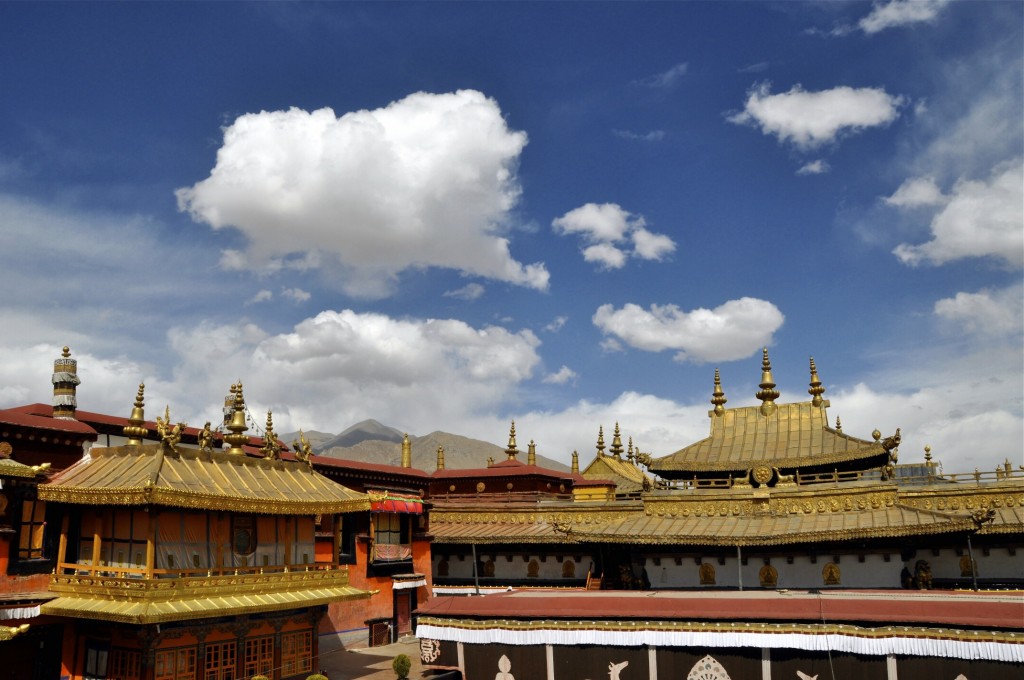
View from the roof of Lhasa’s Jokhang Temple ཇོ་ཁང་གཙུག་ལག་ཁང༌
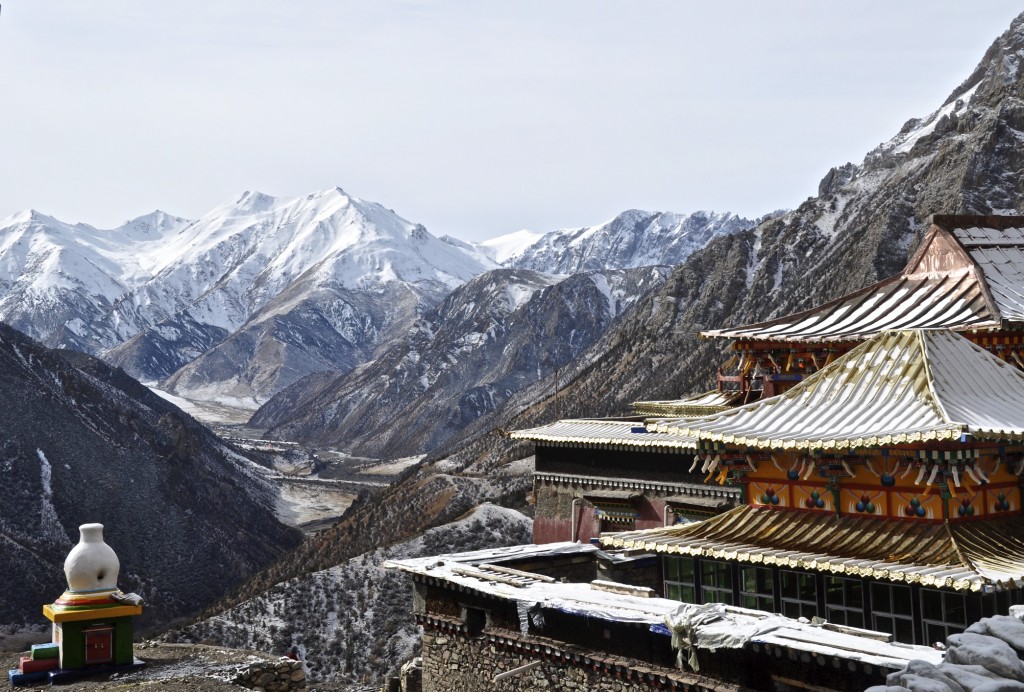
Dana Monastery རྟ་རྣ་དགོན་ in Nangchen county ནང་ཆེན་རྫོང་, Yushu prefecture, Kham (southern Qinghai province)
Applying for Tibet Travel Permits
Since permit is issued in Lhasa, Only your travel agency in Lhasa can applied it in your behalf. So, you will have to send picture of information page of your passport and Chinese Visa to your travel agency in Lhasa. They will take care of all the process of making the permit.
If your country has a free visa policy in China, you can only send the copy of your passport for applying tibet travel permit. Check out which are the countries with free visa policy.
Additionally, mind the number of days it will take to complete the permit. If you are visiting Kailash consider sending the information a month and half prior to your travel date. If you are visiting Lhasa and Everest Basecamp, consider 20 days for your permit process.
Additional Document as per Catagory of your Visa
- If you have a tourist (L) visa, no other documents are required to be sent to the travel agency.
- If you have a student (X) visa, you will need a letter from your school stating that you are an official student there in addition to your passport and Chinese visa. The letter must include your full name, passport number and nationality.
- If you have a business (F) visa, you will need a letter from your inviting company stating your full name, passport number, nationality and position with the company.
- If you have a work (Z) visa or residence permit, you will need a letter stating that you are an official employee of your company.
Tibet Travel Permits normally take 20 days to make. Military and Foreign Affairs Permits can take up to 5 weeks to arrange.
Permit Delivery
The permit then is send to you at a hotel or emailed for you to print and use. If you plan on taking the flight to Lhasa, insist that the original is send to you as you will have a problem trying to board the plane with only a copy of the permit.
If you plan to taking the train to Lhasa, you should have no problem with just a printed copy of the permit.
People holding a journalist visa or a Diplomatic Passport are normally not permit to travel to the Tibet Autonomous Region.
Permits are almost always checked before taking the train to Lhasa and are always checked before boarding flights to Lhasa. Without a permit, you will not be allowed to board a flight or train to Lhasa.
It will be extremely difficult to slip into Tibet without a permit and tour and it will be even harder to stay at a hotel without a permit. Foreigner approved hotels will need to see your permit and passport before you are allowed to stay in them.

Overlooking Yamdrok Lake ཡར་འབྲོག་གཡུ་མཚོ་ with the glaciated peak of Nojin Kangsang གནོད་སྦྱིན་གང་བཟང་ in the background

Nomad family camped along the peaks of Amnye Machen ཨ་མྱིས་རྨ་ཆེན། in Golok prefecture, Amdo (southeast Qinghai)
How to Go to Tibet
There are a few way of getting to Tibet. You can choose to take train to Lhasa, flight to Lhasa or Travel overland to Lhasa.
Train to Tibet
The most common way now is to take the train to Lhasa. There are daily trains to Lhasa originating from Xining, Lanzhou, Chengdu, Chongqing, Beijing, Shanghai and Guangzhou. In addition, the train passes through many other cities along the way. Train tickets during the busy summer tourist season can be extremely difficult to get. The ticket will be open for sale at 15 days proir to your travel date.
For acclimatization purposes, Xining is probably the best option to take the train from as it sits at 2300m/7500 feet above sea level. It is also the closest major city to Lhasa and is the official starting point of the Tibetan Railway.
Flight to Tibet
Another popular way to get to Lhasa is to fly there. There are daily flights to Lhasa from Chengdu, Xi’an, Beijing, Shanghai, Guangzhou, Chongqing and a few other major cities. Chengdu offers the most daily flights to Lhasa with at least 6 to 10 flights per day.
Traveling overland to Tibet
Most adventurous way to travel to Tibet is by traveling overland to Tibet from Nepal or near by Provinces of China. Some of the famous overland route to Tibet is as follow
- Chengdu to Lhasa northern route
- Chengdu to Lhasa southern route
- Shangrila to Lhasa route ( Yunnan to Tibet overland route)
- Kathmandu to Lhasa overland
- Kashgar to Lhasa overland journey
- Xining to Lhasa overland Journey
Purchasing train and flight tickets
In order to purchase train or air tickets to Lhasa, sometimes you will need to show your Tibet Travel Permit. As a foriegner it is nearly impossible to secure train ticket on your own self. Most people prefer paying a little extra and have a travel agency arrange their tickets to Lhasa in advance for them. Getting train tickets during the summer high season can be extremely difficult even for a travel agency.
You can purchase flight ticket from and to Lhasa on all the major international platform without issue.
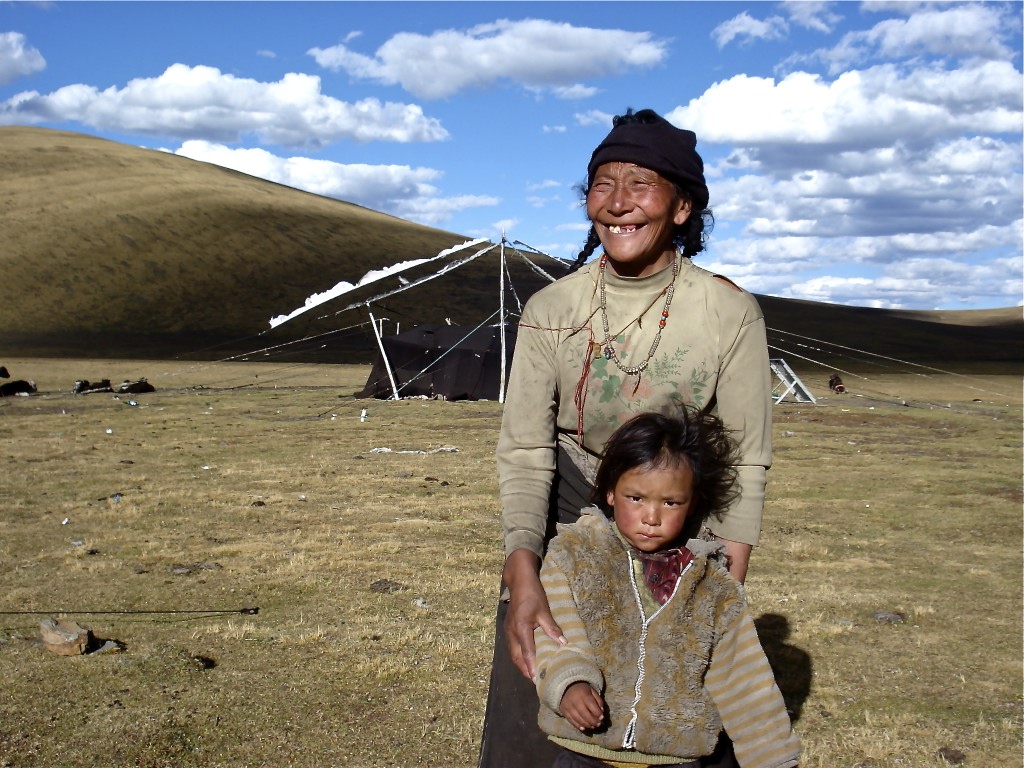
Nomad grandmother with her grandson in Trindu county ཁྲི་འདུ་རྫོང་ in Yushu prefecture, Kham (southern Qinghai)
Transportation in Tibet
While in Tibet, you will have to travel by private vehicle. The only exception to this is if you are only staying in Lhasa. Most agencies will allow you to use taxi’s or public buses to get around if you are only staying in Lhasa.
If you plan on traveling outside of Lhasa, you will most likely travel either by van or 4 wheel drive vehicle. The road conditions in Tibet have dramatically improve over the past 10 years, so more and more vans are now use for tours in tibet. If you are traveling with a larger group, it is also possible to travel by mini-van or private bus depending on the time of year and the conditions of the roads.
Tour Guide
Foreigners must have a tour guide while in Tibet, including in Lhasa. There are no exceptions to this. While in Lhasa, your guide is normally with you for 3 to 5 hours each day and then leaves you to have the rest of the day on your own.
When you travel outside of Lhasa, your guide will accompany you in the same vehicle for the duration of the tour. The influx of over 8.7 million tourists to the Tibetan Autonomous Region (TAR) in 2011 made Tibet a major tourist destination, leading many guides to move to Lhasa for jobs; unfortunately, some new guides are giving the older guides a bad reputation. A few of the newer guides don’t have a high English ability and know little about the sites in Tibet.
The travel agency that you book your tour with will be responsible for assigning a guide to you. While in Lhasa, if your guide is not doing a good job, ask for a change before you depart to Everest or some other remote part of Tibet.

Huge glaciated peak in the Himalaya’s

Nomads from Zoige county, Ngawa prefecture རྔ་བ་ཁུལ་མཛོད་དགེ་རྫོང་ (northern Sichuan) on the move
Hotel Bookings
Most Tibetan owned agencies have many relationships with a wide range of hotels in Lhasa…everything from budget backpacker places to 4 and 5 star hotels. If you know the specific hotel you want to stay at, tell the agency and they can book it for you. If you are unsure which hotel you want to stay at, tell the agency which type of hotel you are looking for, such as budget, mid or high end, and they can make a booking for you.
During the high season it is essential to have your hotel booked in advance. Most hotels in Tibet do not have websites or ways to reserve them on-line. In areas outside of Lhasa, it is not really necessary to make hotel reservations. These small towns usually only have a handful of accommodation options that usually have empty rooms on arrival. For a list of hotels in towns across Tibet, pick up a copy of Lonely Planet’s Tibet guidebook.
Meals
You can choose to have a travel agency arrange all of your meals for you, but it isn’t necessary or required. I recommend doing your meals on your own. That way you can choose what food you want to eat and can be sure that you are not overpaying for a meal that your agency arranged for you.
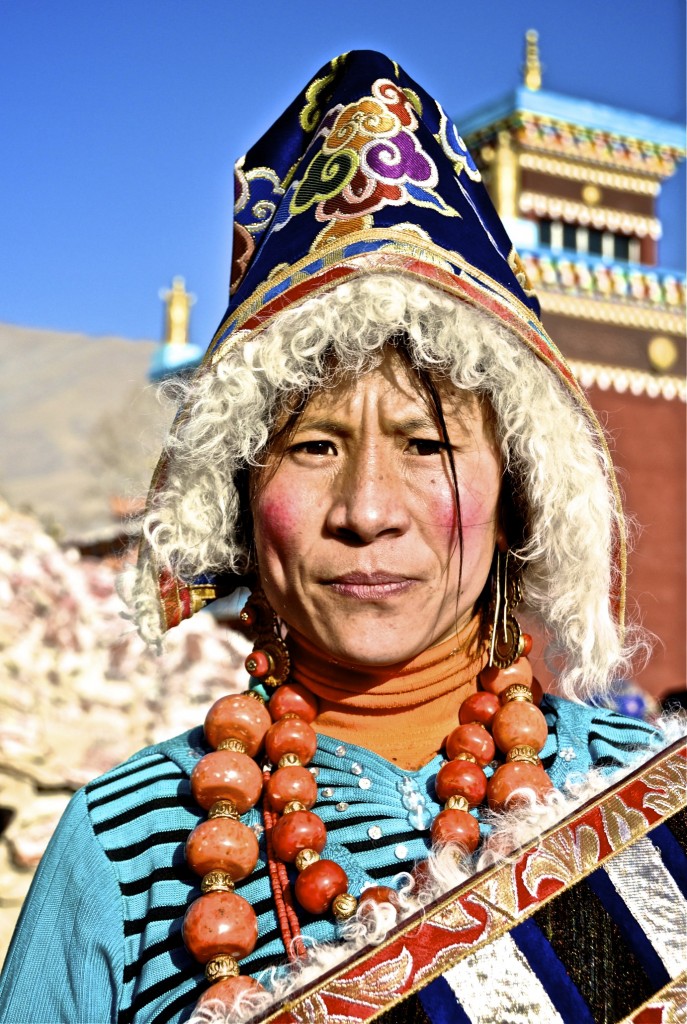
Kham woman from Jyekundo སྐྱེ་དགུ་མདོ་, capital of Yushu prefecture (southern Qinghai)

A monk in Kham reciting prayers
Entrance Fees
You will need to specify with your travel agency regarding if entrance fees into temples, monasteries and parks are include in your tour price. It is best to have these not included in your tour price. That way, you can decide which places you want to visit on your own. If you have the agency pay for the entrance fees and you decide to not visit a certain monastery, it could be difficult getting that amount refunded.
Deposit and Cancellation Fee
Most agencies will require you to pay between a 10% to 50% deposit on your tour before they will process it. Deposits can be pay either bank transfer or Paypal. Make sure your agency is very clear with you on their cancellation fee. Also ask what their refund policy is if you become sick during the trip and have to end the tour early. Most agencies should offer at least some of a refund for a tour that has to end early due to illness.
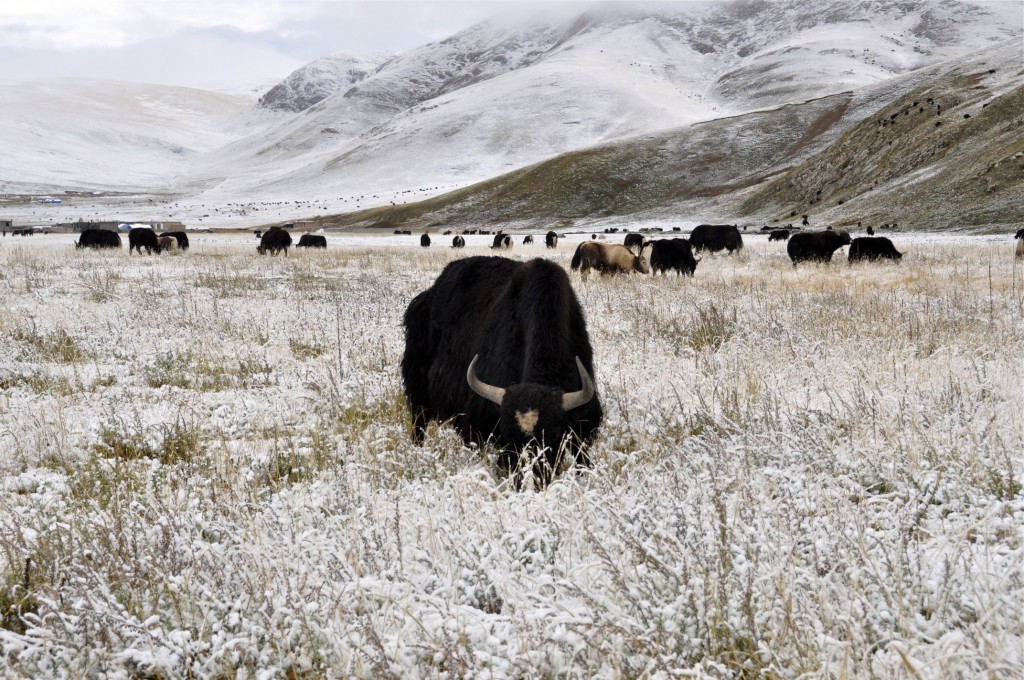
Yaks grazing at 4000 meters
Which Travel Agency?
Choosing a travel agency with a good reputation is very important. Responsible tourism in Tibet is also important. I suggest using a reputable, Tibet-owned/Tibetan-staffed travel agency in Lhasa.
As a general rule, the further away from Lhasa, the more expensive the tour will be. Xining and Chengdu are usually cheaper places to arrange a Tibet tour than Beijing, Shanghai or Guangzhou. Arranging a Tibet tour from an agency outside of China will be the most expensive.
Choosing an agency directly from Lhasa is usually the economical option. I recommend using a Tibeten owned agency to ensure that your tourism money goes to the Tibetan people. Please email me for recommendations on on which travel agency to use: info@thelandofsnows.com
Nepal to Tibet
The advice is above is only for entering Tibet from the rest of China. If you plan on entering Tibet from Nepal, you have to go by much different rules. Please read through the following for the regulations on entering Tibet from Nepal:
Kham and Amdo Regions
The Kham and Amdo regions of the Tibetan Plateau are in Qinghai, Gansu, Sichuan and Yunnan provinces. These areas are home to over 60% of the total Tibetan population and over 50% of the land mass of the Tibetan Plateau. These areas are completely open to foreign travelers and do not require a tour or any travel permits. Many of these areas are completely Tibetan and are the best places to see traditional Tibetan culture. Many repeat travelers to Tibet consider regions in Kham and Amdo to be the best places that the Tibetan Plateau has to offer.
For more information on travel in Tibet, please send an email to info@thelandofsnows.com
Lobsang བློ་བཟང་
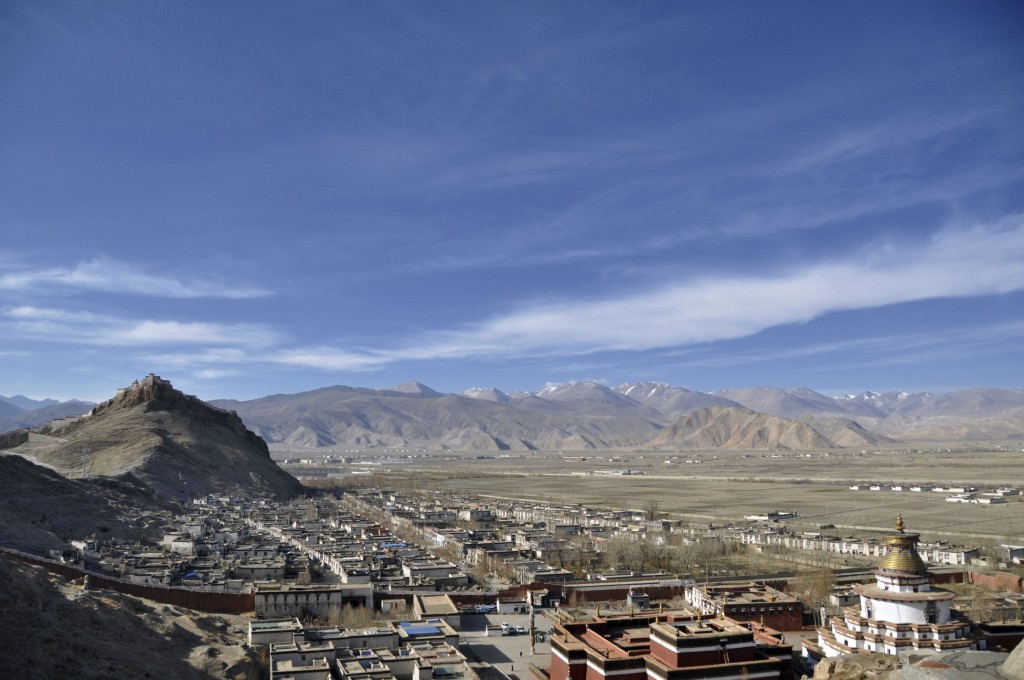
Overlooking Gyantse རྒྱལ་རྩེ་
